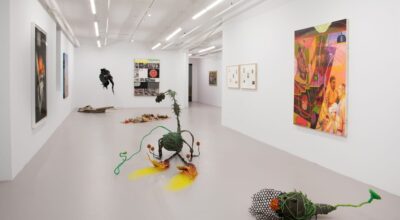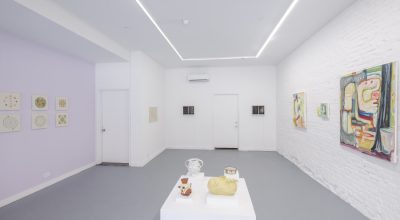
RAÚL DE NIEVES: ETERNAL RETURN & THE OBSIDIAN HEART
By Risa Puleo | Curator
Eternal Return and The Obsidian Heart is, to date, the most comprehensive survey of work by Raúl de Nieves (1983). The exhibition connects the artist’s exuberant material sensibility to his roots in punk music, devotional ritual, and celebratory queerness. The symbiosis between de Nieves’s sculptural work and musical collaborations, including his band Hairbone as well as his operatic performances, had yet to be considered until this exhibition.
De Nieves investigates divinity, desire, and decadence across material, emotional, and spiritual realms. The artist draws inspiration from his childhood spent in Michoacán, Mexico, where public religious ceremonies and private rituals incorporate elaborate costuming and theatrical components. Coming of age in DIY scenes in San Diego and San Francisco also energized de Nieves with a theatrical approach to art making. After arriving in New York in 2007, the artist began working collaboratively on musical projects that transgress genre boundaries into artistic performances. Collaborating with a largely queer milieu of artists, dancers, and musicians, he fronts the noise band Hairbone and has orchestrated a number of operas. Examples of both types of performances play throughout the exhibition to illuminate the symbiosis between de Nieves’s solo sculptural work and his musical collaborations.


In New York, de Nieves also began to articulate his aesthetic of abundance through an economy of means by producing labor-intensive paintings, sculptures, drawings, installations, and environments. The artist transmutes emotional and psychic energy into physical form through a ritual-like process. To create his elaborate anthropomorphic figures, the artist channels emotions through his body into readymade, material containers that include craft store beads, crystals, plastic jewels, sequins, cardboard, transparent acetate, and tape.
From afar, these materials shimmer and seduce, but reveal themselves to be mass-produced and readily available upon a closer look. This meticulous process is the means by which de Nieves imbues his opulent creations with a spiritual essence and power. Such otherworldly power is felt throughout the exhibition and embodied in the artist’s signature “stained glass” installations and multi-genre performances that channel alternate dimensions.
To step into this exhibition is to enter into an awareness of the multiplicity of time. The artist and curator worked closely together to design the exhibition as an immersive Gesamtkunstwerk (total artwork) in which individual sculptures, installations, and audio from performances blend together into a cohesive experience of the spiritual, familial, and self across time.
In the “stained glass” installation Basilio, cosmic time is represented in colorful configurations of planets moving around the sun, which is itself depicted as it appears from Earth at various moments of transit across the sky over the course of a year. The time of a year—measured by the cycle of the four seasons—is also represented in the series of paintings Fall, Winter, Spring, and Summer. This cycle of birth, death, and rebirth repeats throughout the exhibition. Human time—measured in the progression from infancy through adolescence, to adulthood, and into old age—manifests in the myriad gem-encrusted babies who dance between installations. Death and rebirth appear as one concept in the deconstructed sculptural installation Celebration. At the center of the exhibition, a life-size carousel circles endlessly in a performance of fantasy and delirium, referencing the cyclical time of Eternal Return: the idea that time is composed of a limited number of events that endlessly recur in different sequences and combinations.


The time of Eternal Return is populated by archetypes like the Fool, the first card in the tarot, and Saint George, the dragon slayer from medieval lore. Both characters reoccur in de Nieves’s work as they symbolize key moments in life’s unfolding journey. Ancestral time is accessed through objects like obsidian, a central metaphor in the exhibition. The volcanic stone was used by the Olmec and Mexica people of ancient Mexico to make mirrors that also functioned as spiritual portals. Dark and shining—much like the black glass used in the installation Fina—one must look through obsidian’s reflectivity to shift the mirror reflection into a portal for communicating with ancestors.
For de Nieves, art making is a related process of creating a mirror for one’s self; a tool for reflection and a means of externalizing an interior state in order to see possibilities for growth. Eternal Return and The Obsidian Heart offers a holistic look at the ways in which the artist rejoins the spiritual with the material within a contemporary culture that is as familiar as it is magical.

RAÚL DE NIEVES: ETERNAL RETURN & THE OBSIDIAN HEART
The Museum of Contemporary Art, North Miami (MOCA), 770 NE 125th street, North Miami, FL
On view October 15, 2020 – March 21, 2021
También te puede interesar
DE POR VIDA
"De Por Vida" [For Life] brings together thirteen artists whose works portray cycles of life, death and legacy. The exhibition at Company (New York) presents Latinx artists Alina Perez, Bony Ramirez, Diana Sofia Lozano,...
Keepi’n it Real.la Bienal Whitney 2017
A la mayoritaria presencia de artistas femeninas que han sido seleccionadas se ha sumado una inusual cantidad de creadores provenientes de zonas conflictivas y poco exploradas, tales como Irán, Turquía, Vietnam o Puerto Rico....
ISA CARRILLO, CIRCE IRASEMA, LUCÍA VIDALES: TERRA PRETA
"Terra Preta" presents the work of three Mexican artists to consider the sacredness of fertile soil and the relevance of ancient wisdom. Through depictions of Mesoamerican mythology and deity representation, the examination of the...



